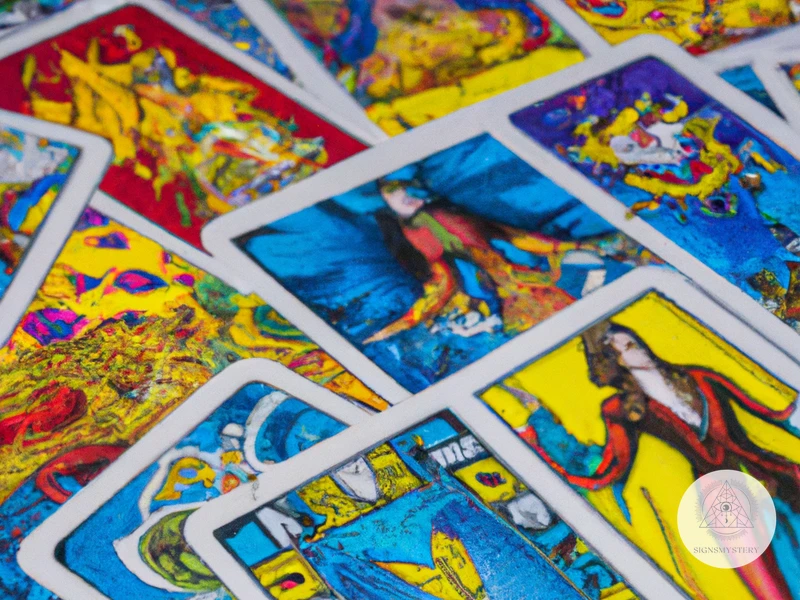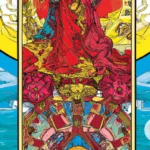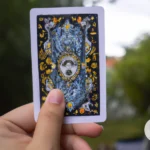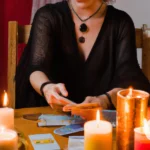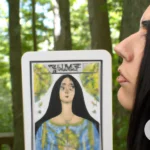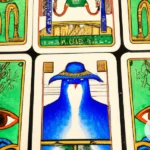Tarot readings have long been a mystical tool for understanding one’s inner-self and the ways of the universe. At the core of these readings are the two main sets of cards – the Major and Minor Arcana. If you’re new to the world of tarot, it’s normal to feel perplexed by the differences and similarities between these cards, as well as how to interpret them when they appear together in a reading. That’s why this article dives deep into exploring the connection between the Major and Minor Arcana in tarot interpretations. From understanding their meanings and differences to exploring ways to combine them in readings, we’ve got you covered. Let’s embark on this journey of learning the intricacies of tarot readings together.
What are the Major and Minor Arcana
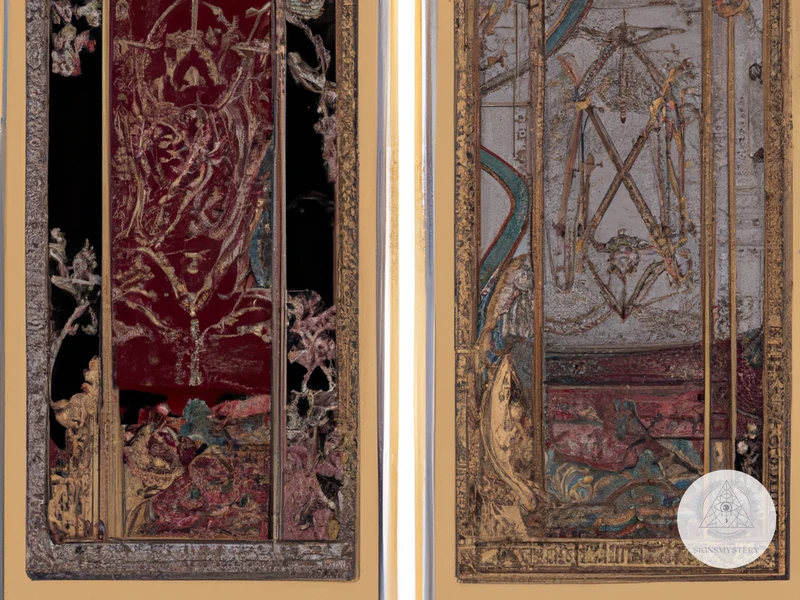
Major and Minor Arcana are the two main categories of tarot cards, each with their own unique characteristics and meanings. Major Arcana consists of 22 trump or key cards, like The Fool or The Hanged Man, that represent major life events and spiritual lessons. On the other hand, Minor Arcana is divided into four suits – Swords, Cups, Pentacles, and Wands – each with 14 cards that correspond to common objects or situations in daily life. Swords relate to intellect and conflict, Cups represent emotions and love, Pentacles signify material possessions and money, and Wands symbolize creativity and passion. Together, Major and Minor Arcana work in tandem to provide insight into the past, present, and future, and can help seekers gain clarity and understanding for decision-making. If you want to learn more about the Fool Card, you can check this link.
Meanings and Symbolism
The Major and Minor Arcana in Tarot cards are full of symbolic meanings that help to guide a seeker towards a deeper understanding of their situation. The Major Arcana cards represent significant life events or milestones, while the Minor Arcana cards represent the everyday details of life.
Each card in the Tarot deck has its own symbolism and meaning. The Major Arcana cards are often considered the most powerful and significant cards in a Tarot deck. These cards include some of the most well-known cards such as The Fool, The Magician, The Empress (read more about The Empress here), and The Tower (read more about The Tower here). They represent larger, more life-altering events in a seeker’s journey.
On the other hand, the Minor Arcana cards are divided into four suits: Wands, Cups, Swords, and Pentacles. These cards represent the everyday details of life, including relationships, work, and daily challenges. While these cards may not have the same level of impact as the Major Arcana cards, they are just as essential for a complete and accurate Tarot reading. (Learn more about the importance of the Minor Arcana here).
Each suit also has its own symbolic meaning. For example, the suit of Wands is associated with creativity, ambition, and drive. The suit of Cups is associated with emotions, intuition, and relationships. The suit of Swords is associated with thoughts, communication, and challenges. Finally, the suit of Pentacles is associated with practical matters, such as money, career, and material possessions. (Read more about understanding the Wands suit here).
When interpreting Tarot cards, it is essential to look at the specific symbolism of each card, as well as the meanings associated with it. This gives a more nuanced understanding of the card’s message and how it applies to a seeker’s situation.
The meanings and symbolism of the Major and Minor Arcana cards in a Tarot deck are crucial to a seeker’s journey towards self-discovery and enlightenment. With a deeper understanding of these cards, a seeker can gain valuable insights and guidance for their lives. (Learn more about the role of Court Cards in the Minor Arcana here).
Differences between the Major and Minor Arcana
The in tarot cards are a crucial aspect to understand for anyone who wants to interpret the cards accurately. The Major Arcana consists of 22 cards in the deck, while the Minor Arcana consists of 56 cards. The first major difference between these two sets of cards is their representation and symbolism.
While the Major Arcana represents key life events and archetypal energies that every person will encounter in their life, the Minor Arcana cards embody more day-to-day experiences. The Minor Arcana cards represent situations and issues that people face in their daily lives.
Another significant difference between the Major and Minor Arcana cards is the way they are numbered and named. Each of the Major Arcana cards is individually numbered, starting with 0 for The Fool and ending at 21 with The World. On the other hand, the Minor Arcana cards are divided into four suits; each suit contains ten numbered cards and four court cards that represent people – Page, Knight, Queen, and King.
The symbolism and imagery of the cards also differ significantly. The Major Arcana cards have strong, archetypal themes behind their meanings, such as death, rebirth, the fool’s journey, and enlightenment. They also have a more spiritual and symbolic nature compared to the Minor Arcana.
The Minor Arcana suits consist of Pentacles, Wands, Cups, and Swords. Each suit represents a particular element – Earth, Fire, Water, and Air, respectively, and each has its unique symbolism and interpretation. The numbered cards symbolize everyday experiences, while the court cards represent different personalities and characteristics.
Finally, the Major Arcana cards are often seen as the primary focus of a Tarot reading, while the Minor Arcana acts as supportive or complementary cards. The Major Arcana cards represent the significant forces at work in a person’s life, while the Minor Arcana cards provide practical advice and guidance on how to deal with everyday challenges.
The differences between the Major and Minor Arcana are essential to understand when interpreting Tarot cards. While the Major Arcana depicts significant events and archetypal themes, the Minor Arcana represents day-to-day experiences and practical advice. Understanding these differences will help you to interpret the cards accurately and provide guidance and insight to those seeking answers.
The Connection between Major and Minor Arcana
The connection between Major and Minor Arcana in Tarot interpretations is essential for providing a comprehensive reading. While the Major Arcana focuses on significant life events or changes, the Minor Arcana represents everyday situations or feelings. However, Tarot readers must understand the relationship between these two Arcana types to effectively interpret the cards. One way to connect them is by using the suit of the Minor Arcana to add depth to a Major Arcana card. For example, the Major Arcana card of the Lovers combined with the suit of Cups from the Minor Arcana can suggest emotional choices or relationships. Another way is by using the numerology of the cards to find patterns. For instance, the same number in different suits often indicates similar themes or influences. By combining these methods, readers can provide nuanced and insightful readings that delve into both the significant and everyday aspects of a person’s life.
Ways to combine Major and Minor Arcana in Tarot readings
Combining Major and Minor Arcana in a tarot reading can enhance the accuracy and depth of the interpretation. Here are some ways to combine them:
1. One-Card Draw
Use a Major Arcana card and a Minor Arcana card to give a comprehensive picture of the situation. The Major Arcana card provides the overarching energy, while the Minor Arcana card adds details and nuances.
2. Three-Card Spread
The three-card spread is a popular tarot reading that uses one Major Arcana card and two Minor Arcana cards. The Major Arcana card represents the current situation and the two Minor Arcana cards provide insight into the past and future.
3. Celtic Cross Spread
The Celtic Cross spread is a complex tarot reading that uses ten cards, including both Major and Minor Arcana cards. Each of the cards in the spread represents a different aspect of the situation, with the Major Arcana cards indicating important life lessons and the Minor Arcana cards providing specific details and advice.
4. Eclipse Spread
The Eclipse Spread is a unique reading that uses both Major and Minor Arcana cards to explore the major changes and transformations that are happening in your life. The Major Arcana cards represent the underlying forces at work, while the Minor Arcana cards provide specific insights into how to navigate them.
5. Court Card Spread
The Court Card spread is a reading that uses only the Minor Arcana court cards to gain insight into a situation. Each of the court cards represents a different personality type, and by examining their interactions, you can gain insight into the dynamics at play in the situation.
By combining Major and Minor Arcana cards in different ways, you can gain a deeper understanding of the forces at work in your life and the best way to navigate them. The key is to experiment with different spreads and find the ones that work best for you.
Examples of Major and Minor Arcana combinations
Tarot readings often involve combining both the Major and Minor Arcana cards to provide insight on different aspects of life. There are several ways to interpret the meaning of these cards, and it largely depends on the combination of cards drawn from each set.
For example, if the High Priestess (Major Arcana) and the Nine of Cups (Minor Arcana) appear in a reading together, it could indicate a deep connection to intuition and desires. The High Priestess represents secrets and hidden knowledge,
Subscribe to Our Newsletter
Sign up to receive the latest news and updates.
Another example can be the combination of the Death card (Major Arcana) and the Ten of Swords (Minor Arcana). While these cards may seem ominous individually, together, they may represent a necessary ending to a difficult situation. The Death card represents a major transformation or change, while the Ten of Swords signifies an end to a difficult cycle. The combination of these cards may indicate an end to a painful chapter, leading to brighter prospects in the future.
The Hermit (Major Arcana) combined with the Four of Cups (Minor Arcana) could suggest a period of introspection and self-discovery. The Hermit represents solitude and withdrawal, while the Four of Cups signifies contemplation and introspection. Together, they imply that the seeker may need to take a step back from external distractions and focus on their inner world for a while, leading to enlightenment and personal growth.
These are just a few examples of the different ways Major and Minor Arcana cards can be combined to provide insight and guidance in tarot readings. It is important to remember that the interpretation of these cards can be highly personal and depend largely on the individual’s personal experiences and beliefs.
How to give interpretations based on Major and Minor Arcana combined
Giving interpretations for combined Major and Minor Arcana in Tarot readings can be a daunting task, as each card carries strong symbolism and meanings that can affect the overall message being conveyed. However, with the right approach and careful consideration, it is possible to create a cohesive and nuanced interpretation that accurately reflects the querent’s situation and needs.
One approach to interpreting Major and Minor Arcana combinations is to first consider the overall theme or message of the reading. Is it focused on love and relationships, career and finance, or personal growth and development? Understanding the overarching theme can help identify which cards are most relevant and how they interact with each other.
Next, it’s important to look at the individual cards and their meanings in relation to the theme. For example, if the theme is career and finance, a combination of The Magician (Major Arcana) and the Ace of Pentacles (Minor Arcana) may indicate the querent has the skills and potential to manifest their desired financial goals. However, if the combination instead features The Devil (Major Arcana) and the Five of Pentacles (Minor Arcana), it may suggest the querent is struggling with materialism or addiction that is hindering their financial growth.
Another technique is to look at the positions of the cards in the spread and how they interact with each other. For example, a combination of The Fool (Major Arcana) and the Ten of Cups (Minor Arcana) may suggest that the querent is embarking on a new romantic or creative venture that will bring long-term happiness. However, if the Ten of Cups is positioned before The Fool, it could indicate the querent is seeking happiness and fulfillment through misguided or unrealistic pursuits.
It’s important to note that there is no one-size-fits-all approach to interpreting Major and Minor Arcana combinations in Tarot readings. Each reading and querent is unique, and interpretations should be tailored accordingly. Over time, with practice and continued study of Tarot symbolism and meanings, interpreting Major and Minor Arcana combinations will become more intuitive and natural.
To summarize, when giving interpretations based on Major and Minor Arcana combined:
- Consider the overall theme of the reading
- Look at the individual cards and their meanings in relation to the theme
- Consider the positions of the cards in the spread and how they interact with each other
By following these techniques and remaining open to the intuition and insight provided by the Tarot, one can provide accurate and meaningful interpretations that will resonate with the querent and provide insight into their current situation.
Conclusion
In conclusion, the Major and Minor Arcana cards in tarot interpretations are two essential components used to read a tarot spread. The Major Arcana cards represent significant life events and themes, while the Minor Arcana cards describe everyday situations.
By acknowledging the meanings and symbolism behind each card, tarot readers can make a connection between the Major and Minor Arcana. The combination of these cards adds depth to the reading, conveying a more detailed message.
Various ways exist for combining the Major and Minor Arcana in a tarot reading, such as creating a spread that includes both types of cards. Examples of these card combinations can help readers to understand how they relate to each other and how to interpret them correctly.
When giving interpretations based on Major and Minor Arcana combinations, it is essential to consider the context of the situation and the meaning of each card. Consider the significance of the Major Arcana card in the reading and how it interacts with the Minor Arcana cards.
In short, the use of both the Major and Minor Arcana cards in tarot readings requires practice and skill. The connection between these two components can add depth and clarity to a reading, enabling the tarot reader to provide a comprehensive interpretation for the client.
Frequently Asked Questions
1. Can I use only Major or Minor Arcana cards in a Tarot reading?
Yes, you can use either Major or Minor Arcana cards in a reading depending on your personal preference and the purpose of the reading.
2. How many cards are in the Major Arcana?
There are 22 cards in the Major Arcana, each with its own unique symbolism and meaning.
3. Can the Minor Arcana cards represent people?
Yes, the Minor Arcana cards can represent people, but they are typically used to represent situations and events.
4. What is the most important card in the Major Arcana?
The most important card in the Major Arcana is the Fool, as it represents the beginning of a journey and the potential for new beginnings.
5. Can I mix Major and Minor Arcana cards in a single spread?
Yes, it is common to mix Major and Minor Arcana cards in a single spread, as they can provide additional insight and depth to the reading.
6. Are the meanings of the cards set in stone, or can they change depending on the situation?
While each card has a traditional meaning, the interpretation of the card can change depending on the situation and the intuition of the reader.
7. Is it necessary to memorize all the meanings of the cards?
No, it is not necessary to memorize all the meanings of the cards. Many readers prefer to work with their intuition and allow the cards to speak to them in the moment.
8. Can the same card have different meanings in different spreads?
Yes, the same card can have different meanings in different spreads based on the context and the other cards in the spread.
9. How can I determine which spread to use for a particular question?
You can select a spread based on the complexity of the question and the depth of the answer you are seeking.
10. Is it necessary to have a specific question in mind before doing a Tarot reading?
No, it is not necessary to have a specific question in mind. A general reading can provide insight and guidance on your overall situation and direction.

